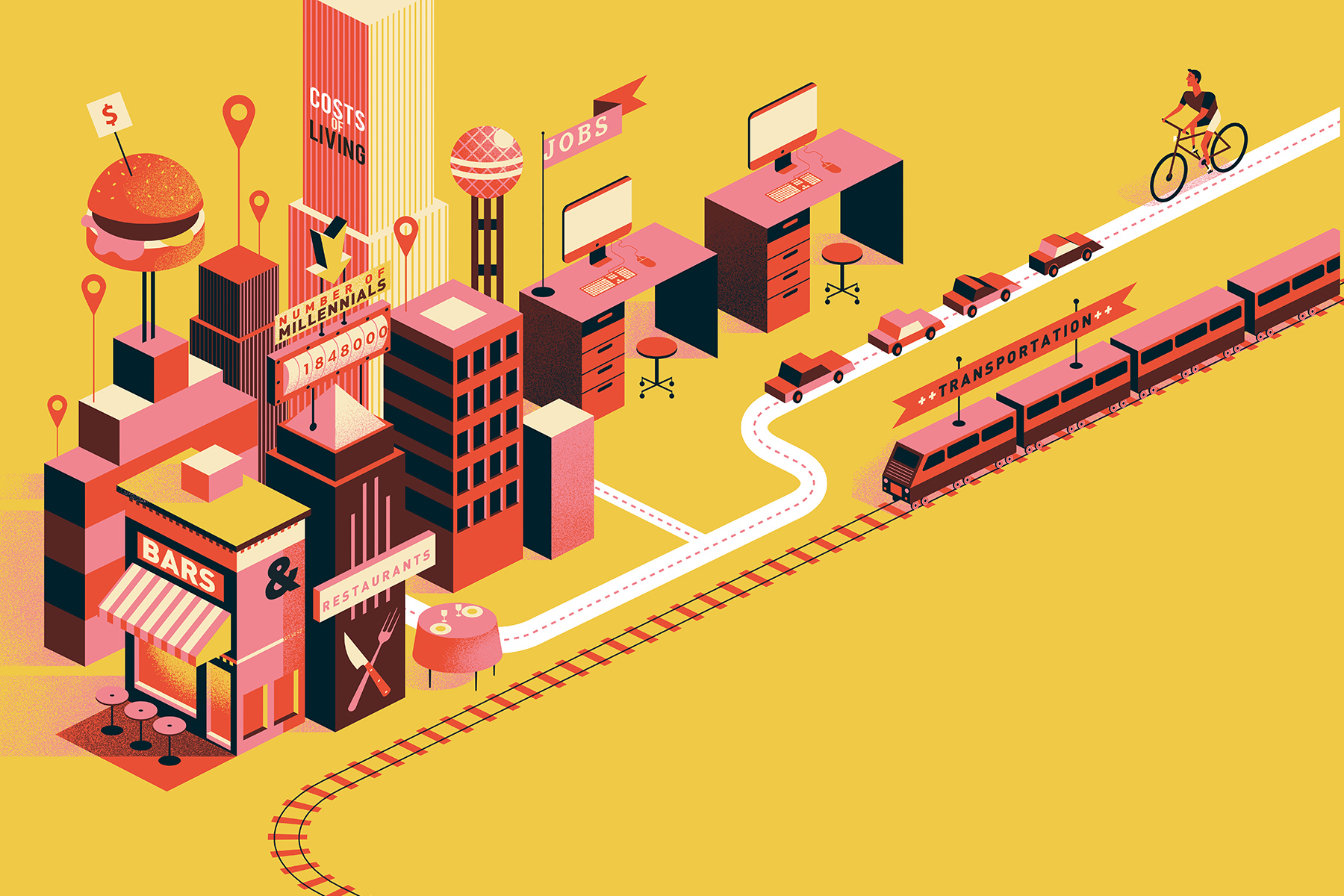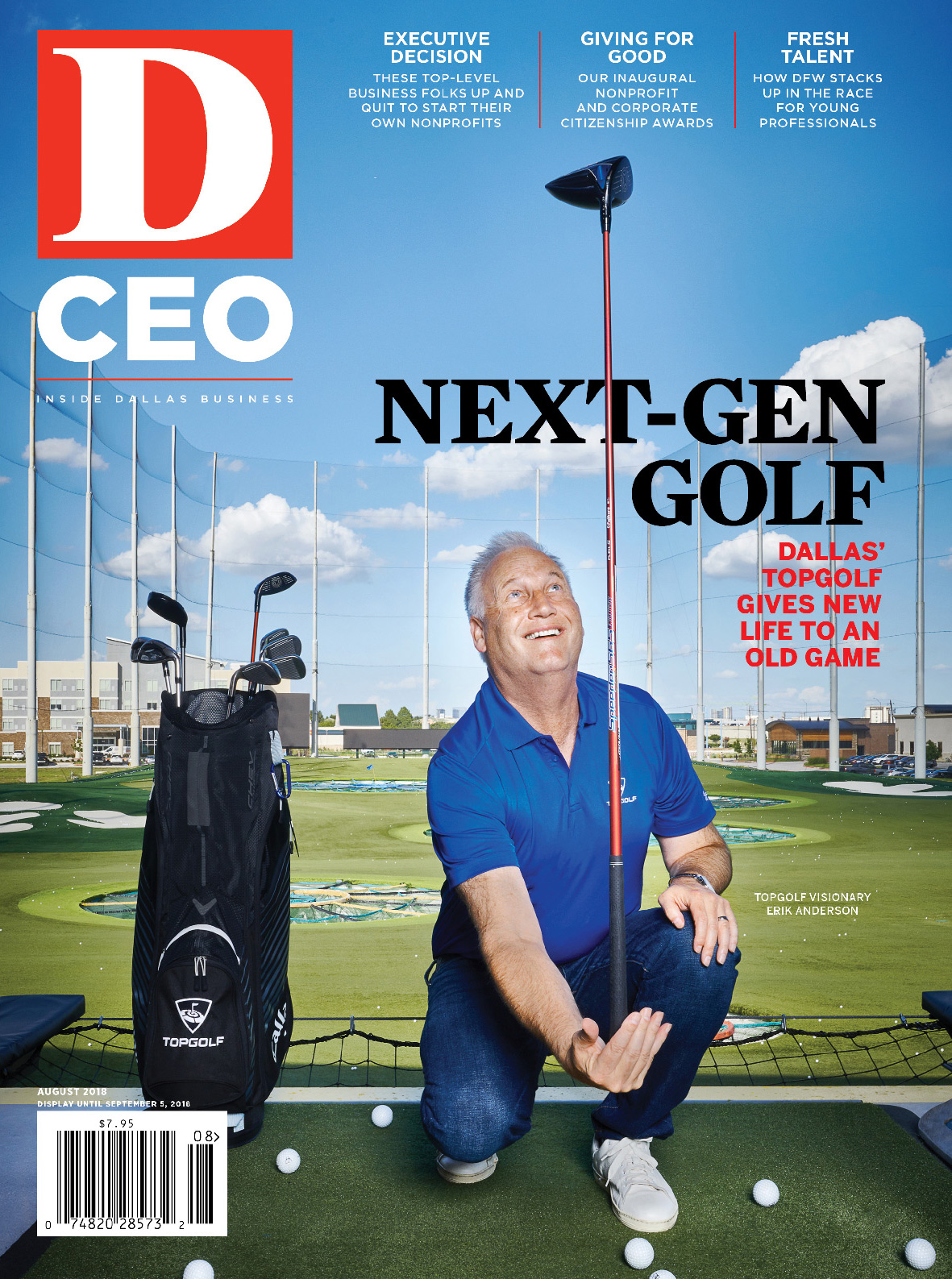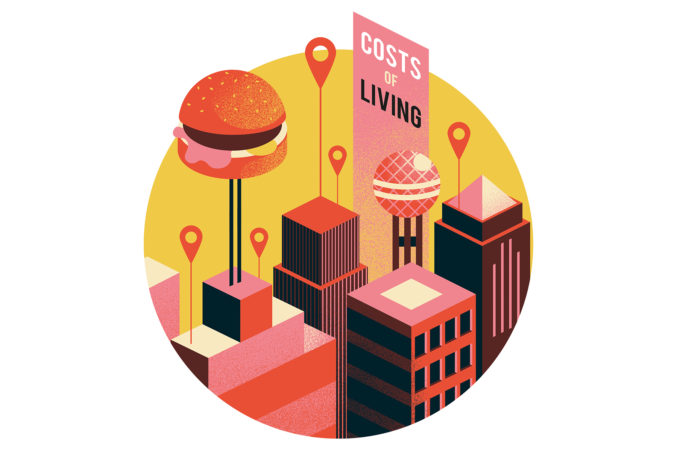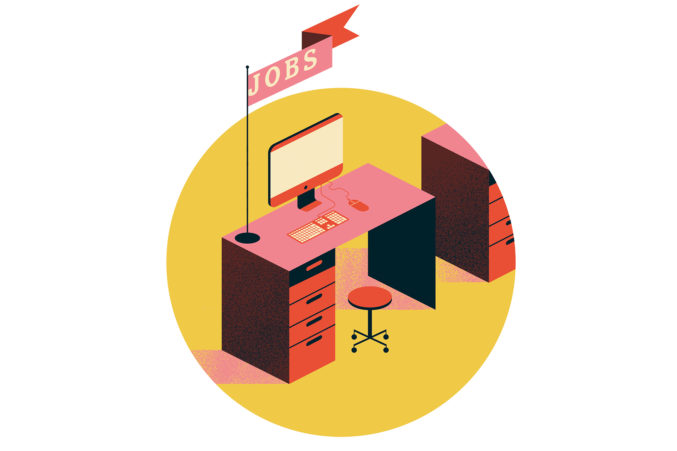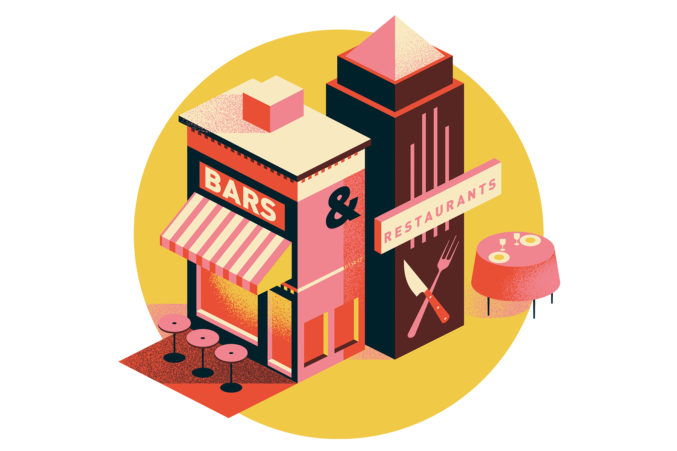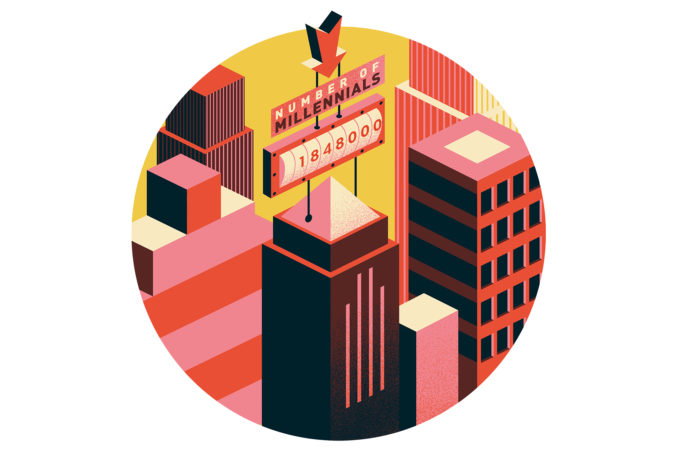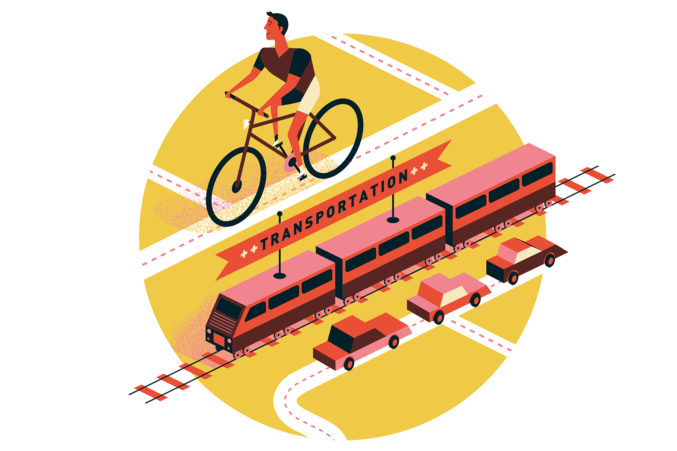Cities nationwide are competing to lure the most talented and productive workers. And as much of the workforce eyes retirement, the most sought-after workers are millennials. Dallas-Fort Worth is no exception.
DFW is a hotspot—the best place for young talent to grow their careers and thrive in a lively, affordable environment. That’s what the Dallas Regional Chamber wants the youthful workforce to believe, anyway. The message is part of the chamber’s “Say Yes to Dallas” campaign, which launched in April 2017 and has told millennials nationwide, “There’s no better place to be” than DFW. The campaign even received help from Dallas Mavericks owner Mark Cuban, who offered relocating millennials the chance to win Mavs tickets.
The chamber is targeting young workers as a means to economic growth. That’s smart, because millennials represent the country’s largest generation and are likely to be the most mobile, says William Frey, senior fellow at The Brookings Institution. “Most people that move are young adults,” Frey says. “They move when they get out of college, get new jobs, get new homes. … So when it comes to overall migration patterns, millennials are a big part of it.”
D CEO wanted to know just how well DFW actually stacks up against its biggest rivals—the country’s top metropolitan areas according to gross domestic product—in attracting the millennial workforce. The top 10 metros, in order, are New York-Newark-Jersey City; Los Angeles-Long Beach-Anaheim; Chicago-Naperville-Elgin; Dallas-Fort Worth-Arlington; Washington-Arlington-Alexandria; Houston-The Woodlands-Sugar Land; San Francisco-Oakland-Hayward; Philadelphia-Camden-Wilmington; Boston-Cambridge-Newton; and Atlanta-Sandy Springs-Roswell.
We analyzed five key components for attracting millennials to these top metros. For this article, millennials were defined as people between the ages of 20 and 34 in 2016. Our conclusion: DFW has some attractive assets but, when compared to our chief competitors, also has some work to do before becoming a true hotspot for the millennial workforce.
How We Rank Against the Nation
Affordability
Measure: Consumer goods, rent, and other costs
Millennials often carry heavy college debt loads and aren’t making a ton of money when they begin their careers. So the cheaper it is to live somewhere, the more attractive it is to young guns.
This is where DFW shines. The region ranks second in affordability, according to the U.S. Bureau of Economic Analysis’ 2016 release of regional price parities. The report details each metropolitan area’s price levels of consumer goods, rent, and other costs as they relate to the national average.
Our cost of living, according to the BEA, is only .2 percent above the national average. The data typically corresponds with the highest and lowest rents, the BEA reports. And that seems to be the case for DFW, which ties Houston for the second most affordable rents.
The median rent rate for DFW residents was $1,022, according to the U.S. Census Bureau’s 2016 American Communities Survey, which the BEA uses for its reports. D CEO also obtained rent rates for one-bedroom apartments across metro areas. A one-bedroom apartment in DFW cost $994, the second most affordable region next to Houston, which came in at $967, according to RealPage.
The most affordable metro area among the top 10, according to the BEA, is Atlanta, which also had the most affordable rents overall. Unsurprisingly, San Francisco and New York, respectively, were the most expensive metros. A millennial living in San Francisco would pay 24.7 percent more than the national average, data shows.
Job Opportunities
Measure: Entry- and mid-level job openings per local worker
Among the advantages the regional chamber says in its “Say Yes to Dallas” campaign, competitive career options is key.
DFW had more than 125,000 job openings in the month of June, according to Gartner’s TalentNeuron. About 80,000 of those jobs were entry- to mid-level, meaning they required anywhere from zero to seven years of experience. For this study, D CEO focused on entry- and mid-level jobs, since those are the positions most millennials would vie for.
The metros with the most available jobs for millennials were Houston, Philadelphia, and Washington, D.C.
Top full-time occupations in demand included software developers, registered nurses, marketing managers, and first-line supervisors of retail sales workers, data shows.
DFW ranked seventh in jobs availability, when the local entry- and mid-level workforce was compared to the number of job openings. The metros with the most available jobs for millennials were Houston, Philadelphia, and Washington, D.C. The tightest, most competitive markets, ranked at the bottom, were Atlanta, Los Angeles, and San Francisco.
Moral of the story: DFW has a lot of job opportunities. But competition with a robust local workforce will likely make these jobs harder to land.
Access to Fun
Measure: Bars, restaurants, and entertainment per 10,000 households
For millennials, access to bars, restaurants, and entertainment is key. Surveys have shown that millennials spend more in bars, on coffee, and at restaurants than any generation before them. So if you want to attract young professionals to your city, you better bring the fun.
When it comes to DFW, however, hotspots aren’t as prevalent as in other large metro areas. Out of the 10 biggest metropolitan areas, Dallas-Fort Worth ranked No. 8, edging out only Philadelphia and Houston. Los Angeles and New York topped the list.
The scores were based on the total number of places to eat and drink alcoholic beverages per 10,000 households, plus the total number of places for arts, entertainment, and recreation per 10,000 households. Data was pulled from the 2016 County Business Patterns released by the Census Bureau.
DFW fared better in the food and drink category, but was weighed down by its entertainment score. For the sake of this study, entertainment is defined as establishments that offer live entertainment and public exhibits; preserve objects for historical, cultural, or educational purposes; or provide recreational activities. DFW ranked No. 7 in food and drink, providing nearly 50 places to dine or drink per 10,000 households, compared to top-ranked San Francisco, which offered nearly 69 places. But in entertainment, DFW ranked ninth, providing nearly eight places per 10,000 compared to top-ranked Los Angeles, which offered nearly 38.
Overall, DFW can offer millennials about 58 places to eat, drink, or enjoy themselves per 10,000 households. Los Angeles and New York provide nearly 101 and 83 places, respectively.
Long story short, when it comes to providing fun for millennials, DFW leaves something to be desired.
Millennial Population
Measure: Percentage of millennials per population
There’s nothing like moving to a new city and instantly having a large group of peers at your side. So naturally, a millennial might find a city with a pool of young peers more attractive than, say, a sleepy retirement town.
A millennial might find a city with a pool of young peers more attractive than, say, a sleepy retirement town.
And while DFW has a decent number of young professionals roaming its streets, some top 10 metros offer a more relatable atmosphere for millennials. To compare regions, D CEO analyzed the percentage of millennials living in each area, based on 2016 Census numbers.
DFW ranked seventh out of the 10, with millennials accounting for 21.31 percent of the population. Los Angeles topped the list, followed by Boston, San Francisco, Houston, Washington, and New York. The Chicago, Philadelphia, and Atlanta regions trailed DFW. For kicks, D CEO also analyzed Austin, which beats all of the top 10 metros, with millennials representing nearly 25 percent of its population.
If millennials are looking for the college-town vibe found in Austin, they’d be better off in cities like Los Angeles, Boston, or San Francisco. But DFW isn’t too far behind New York in terms of age diversity. So, depending on the atmosphere a millennial seeks, DFW could still be an interesting place to mix with people across generations.
Ease of Navigation
Measure: Commute times, public transportation, bike friendliness, and walkability
When it comes to transportation, no one likes to sit in traffic or spend hours commuting to work. Millennials take this a step further, preferring walking over driving, according to a recent report from the National Association of Realtors.
To determine how easy it is to navigate the top 10 metro areas, D CEO analyzed data and scored each region based on its commute times to work by private vehicle, percentage of commuters using public transportation, bike friendliness, and walkability. Scores were based on data from the census’ 2016 American Communities Survey as well as Walk Score, a private company that analyzes bike friendliness and walkability.
DFW struggled in ease of navigation compared to its big rivals. Out of 10, DFW ranked ninth, beating only Houston. The top three metros for navigation were New York, Washington, D.C., and Los Angeles, respectively.
The median commute time for people who drove their personal vehicles to work in DFW was between 45 and 59 minutes. Meanwhile, just 1 percent of commuters here use the public transportation system to commute to work. That’s arguably because DFW’s public transit systems are limited in the areas they serve. DFW is also characterized as “somewhat bikeable,” the lowest range Walk Score gives for biking, and “car-dependent,” a category in which “most” (but not all) errands are done by car.
DFW can be thankful it’s not Houston, where median commute times are more than an hour. But it has a long way to go to reach the ease of navigation in New York.


